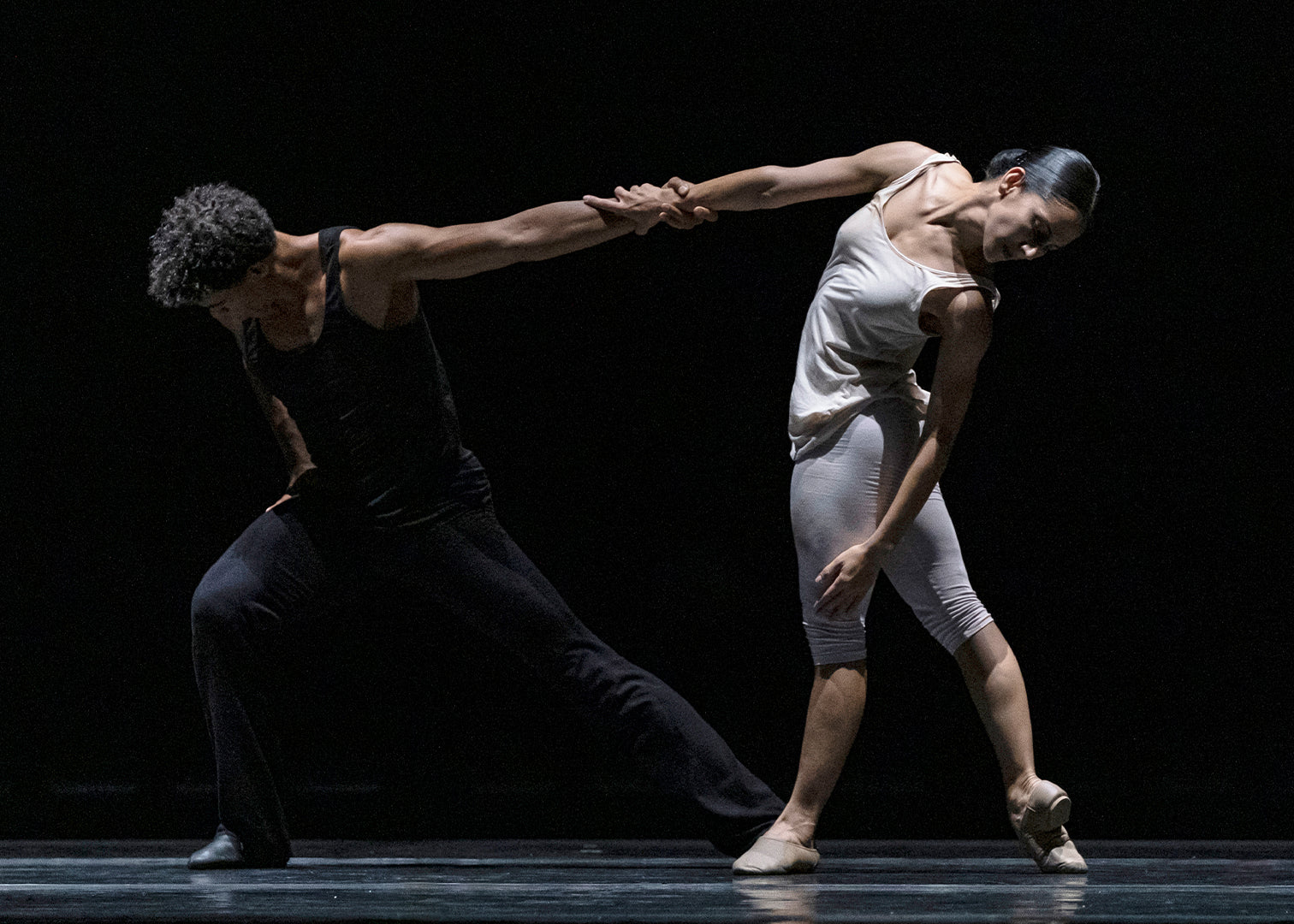He is Kyle Abraham and, with his 10-member, multiracial troupe (founded in 2006), he’s on a roll, having created the two-act, evening-length, “The Watershed” and the triptych, “When the Wolves Came In,” during that two-year residency. The works were inspired by the 150th anniversary of the Emancipation Proclamation, the civil rights movements in South Africa and the United States, and by drummer/composer Max Roach’s monumental 1960 protest album, We Insist! Freedom Now Suite, which was created with writer/singer Oscar Brown Jr.
Heady stuff, to be sure, with “The Watershed” a less successful evening, despite authoritative dancing and Glenn Ligon’s powerful set design crafted from plastic tubing and fraught with symbolism as it began with “branches,” only to become bare in the second act, suggesting the naked depravity of lynchings.
Abraham’s message of racism and what it wreaks, though, is heavy-handed: Dan Scully’s video design—images of Shirley Temple hoofing with Bill “Bojangles” Robinson in 1935’s The Littlest Rebel and a cautious love scene from the 1975 film, Mandingo, bled into looped footage of police brutality—fire hoses, blood-thirsty dogs—bringing to mind the deadly horrors of Ferguson, Cleveland and Staten Island.
Yes, we get the point, but hammering the viewer often distracts from the dance.
Which, as Abraham’s unique vocabulary of postmodern abstract moves, or, as he calls it, “a postmodern gumbo”—demands our attention: Here we had Catherine Ellis Kirk teeming with energy, fluid and luscious, her quicksilver torso action smoothly morphing into stasis. Abraham, too, had it going on in his swaying hips before hurling himself off balance and into a ramrod upright position.
In other words, Abraham can dance, and at one point was clad in Karen Young’s frothy drag wear—a dress, heels and an enormous white Afro wig—beautifully partnered by/with Jordan Morley, with William Briscoe later taking up the drag mantle.
But Abraham’s use of the video footage and projected text is another matter.
We understand that he’s exploring cross-cultural power plays in the name of freedom—and that the work attempts to scrutinize more than race, with the choreographer trying to convey struggles of gender identity and homosexuality (Abraham, born in 1977, identifies himself as a “Black Gay American Man”). But with the violence too in-your-face, and also once removed, the screen imagery and stage cavortings seemingly oppose, not complement, each other.
Bluntly put, where was the emotion? The heft? None surfaced in the videos, which also included minstrelsy (have we become inured to such scenes or have we just taken the past for granted?). Nor did the music (no less than 15 composers were credited), including industrial noise, as well as Otis Redding songs, which gave “The Watershed” a jukebox musical feel, make for a satisfying, cohesive work.
And while the unison with raised hands (“Don’t shoot!”), was also too obvious, the nail in the dance coffin was sealed in the bizarre finale, set to music from the temple scene from Verdi’s “Aida.” Was Abraham being ironic or was he merely trying to suffocate his audience (Aida was buried alive with Radamès in his tomb), with aural kitsch, lessening the impact of the dance. And if so, why?
Happily, the choreographer redeemed himself in “When the Wolves Came In,” the afore-mentioned triple bill. A high-octane evening that made sense, where one wasn’t bludgeoned with the sins of racism and Scully’s video design—he also created the stellar lighting—worked here, his backdrop of cloaked silhouettes ebbing across a bright white landscape that occasionally evoked Kara Walker-like silhouettes. We were also lavishly treated to more cool moves from the Pittsburgh-born Abraham, including nods to Brazilian capoeira, ballet and even the Lindy Hop. That famous frenzied dance recalled Frankie Manning in the 1941 film, Hellzapoppin’, Young’s colorful shirtwaist dresses also reminiscent of the Mad Men, ‘50s era, making for a juxtaposition of wild abandon and constrained mores.
The first part, “When the Wolves Came In,” set to the choral track by composer du jour, Nico Muhly, featured dancers brandishing sky-high, beehive wigs, eye-candy, for sure (serendipitously echoing L.A. Opera’s mounting of “Ghosts of Versailles,” John Corigliano’s 1991 grand buffa work with an elaborately bewigged and costumed cast, currently running through March 1 in downtown L.A.). One wig was ritualistically removed from Hiroki Ichinose, metaphorically an unfettering, perhaps (and something we’d like to see from Sia, the pop songstress of “Chandelier”).
Ichinose also assumed a Nijinsky-like “Afternoon of a Faun” pose, another move culled from Abraham’s well-stocked arsenal, with to-die-for arabesques and pirouettes on view one moment and fabulous cock-of-the-walk strutting and booty shaking the next. The superbly articulate dancers also included Penda N’diaye, Matthew Baker, Connie Shiau, Guy, Ellis Kirk and Morley.
In the trio, “Hallowed,” set to spirituals by Cleo Kennedy and Bertha Gober, images of Alvin Ailey’s “Revelations” were conjured (it’s no surprise that Abraham made, “Another Night,” for that company, which premiered at New York’s City Center to rave reviews in 2012). The dancers, again deploying shifts of weight and off-center balances, reinforced Abraham’s notion of determination, grit and fortitude. Jeremy “Jae” Neal proved a tower of undulations, his hands also a-throbbing, while Guy and Ellis Kirk helped give the work a pietà-like feel.
The exuberant, “The Gettin’” had the ensemble, including Vinson Fraley, clad in Young’s street clothes as well as the throwback ‘50’s garb, while the backdrops, more circumspect here, nevertheless evoked the black/white separation of apartheid and segregation in the States. Grammy Award-winning jazz pianist/composer Robert Glasper contributed original music (on tape), fully capturing Roach’s powerful score of protest and resilience. To the rousing strains of “Freedom Day” (“Slave no longer …”), the dancers were in a gorgeous groove, the final tableau a solemn one, however, with a lone woman—Guy—center stage as the singer intoned, “I am the gold I mined, the trails I blazed …”
Keep on blazing, Kyle Abraham, a vibrant spark in today’s chilly landscape.









comments